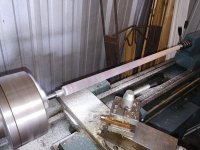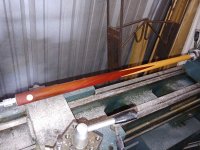You are using an out of date browser. It may not display this or other websites correctly.
You should upgrade or use an alternative browser.
You should upgrade or use an alternative browser.
I still don't...
- Thread starter Billiard Architect
- Start date
Show of as much as you like. What you're doing is cool.
Best of luck.
Best of luck.
Make sure you post a few pics. as you continue and when complete. Looks great so far.
Wow, that's a pretty heavy duty lathe. Cool project.
In a future restoration, I would also consider stripping the finish chemically first, to preserve as much cue as possible, although I would certainly avoid the Dufferin logo.
The Dufferin cues are very thick, a stout taper. They will need a taper pass to be close to modern size
The Dufferin cues are very thick, a stout taper. They will need a taper pass to be close to modern size
Yeah I meant for other kinds of cue restorations. A lot of cue refinishers just slap a cue on the lathe and start sanding away, without considering the possibility of chemically stripping followed by light sanding to retain the dimensions. Also, dings can be raised through heat/steam so the entire cue can retain the original surfaces.
Yeah I meant for other kinds of cue restorations. A lot of cue refinishers just slap a cue on the lathe and start sanding away, without considering the possibility of chemically stripping followed by light sanding to retain the dimensions. Also, dings can be raised through heat/steam so the entire cue can retain the original surfaces.
This one had a couple of minor dings I was able to raise with just wet sanding. It does have a surface crack. I will dimension it out next weekend and see where I am sitting. I am still waiting for my 5/16 14 tap. They sent the 7/16 14 but failed to ship the 5/16.
The Dufferin cues are very thick, a stout taper. They will need a taper pass to be close to modern size
I am going to do my measurements next week after putting it through hell this weekend. See where I sit with my existing 5/16 14 shafts. This was more for getting joint practice. I have 3 Dufferins to play with. This is going to be my no frills butt. I may step up the next one with some round inlays for fun. Just learning for now. I do have a Titlist that I will be working up to. I will see how comfortable I am with it by the third Dufferin.
Wow, that's a pretty heavy duty lathe. Cool project.
In a future restoration, I would also consider stripping the finish chemically first, to preserve as much cue as possible, although I would certainly avoid the Dufferin logo.
I thought of that. Just learning now what is possible. These cues I got from pool halls that had them sitting in the back room. Either got them for free or paid less than 5 bucks for them. Working my way up to my Titlist.
Nice!
But I bet ol' Nine Fingers had your best interests in mind.
LOL... We called him "Lefty"
I do have a Titlist that I will be working up to.
When you go to refinish, try alcohol on it.
If that does not cut it, try lacquer thinner.
BBC used french polish (shellac) in early cues. It can be removed, or even renvated, with alcohol. The process is a little tough without experience because the alcohol evaporates so fast. But keeping it wet and using a nubby towel can make fast progress. Grey scotch brite with a rag over it, even faster but can catch & pull splinters.
LOL... We called him "Lefty"
We had to call ours "Crafty". He wrote books on trowel trades, but his brother was already world famous as Lefty Kreh.
smt
I thought of that. Just learning now what is possible. These cues I got from pool halls that had them sitting in the back room. Either got them for free or paid less than 5 bucks for them. Working my way up to my Titlist.
Keep your eye out for old Dufferins with Purple Heart or ebony butts...
...they made a fair amount...Dufferin bought exotic wood by the ship load,
...I even managed to get bocote and yellow heart on cues where I couldn’t have got the
the block of butt wood for that price.
Depending on the age, there will be three different thicknesses and qualities of finish...
...the oldest ones have very thick finish, then some months of bad ones that crack, then
the most have a good finish...some sort of high tech process.
Nice!
But I bet ol' Nine Fingers had your best interests in mind.
A lot of metal shop folks won't allow wood on their lathes. I believe that sawdust is both abrasive and gets everywhere, so the issue is wear on the ways. (this assumes the shop was a metal shop of course
Dave <-- turns wood on his 10 x 20 metal lathe whenever needed ... and cleans up all dust with a vacuum (never compressed air) when done
Agree with Dave.
I've been to a number of foundry pattern shop auctions (& scads of machine shop auctions).
The metal working machinery in the woodworking pattern shops is always the most worn, rounded edges, sloppy ways, rocking spindles. Even machine dials gradually erased.
Re-scraped the ways on a number of my machines (made them like new geometry & accuracy), but am old enough will still use them sometimes for wood. With trepidation & a vacuum cleaner.
Sanding on lathes is about the worst. Just creating a constant lap out of the slides.
But what do you do if you want to make cues?

smt
I've been to a number of foundry pattern shop auctions (& scads of machine shop auctions).
The metal working machinery in the woodworking pattern shops is always the most worn, rounded edges, sloppy ways, rocking spindles. Even machine dials gradually erased.
Re-scraped the ways on a number of my machines (made them like new geometry & accuracy), but am old enough will still use them sometimes for wood. With trepidation & a vacuum cleaner.
Sanding on lathes is about the worst. Just creating a constant lap out of the slides.
But what do you do if you want to make cues?
smt


